This article contains too many or overly lengthy quotations .(May 2020) |
Buddhist poetry is a genre of literature that forms a part of Buddhist discourse.
This article contains too many or overly lengthy quotations .(May 2020) |
Buddhist poetry is a genre of literature that forms a part of Buddhist discourse.
The first examples of Buddhist poetry can be found in traditional scriptures such as the Dhammapada , according to which, Siddhārtha Gautama (the founder of Buddhism), upon his reaching enlightenment, proclaimed:
Anekajātisaṁsāraṁ, | Through the round of many births I roamed |
Traditionally, most Buddhist sutras have a prose component supplemented by verses (known as gatha) that reiterate and poetically summarize the themes of preceding prose passages. Gatha functions as a mnemonic device helping the Buddhist practitioner commit to memory a certain doctrinal maxim. And in fact, the earliest extant forms of Buddhist discourse appear in verse, which is hardly surprising, considering that the texts were not originally written, but memorized. Linguistic analysis shows that the prose component of the sutras is likely to have been modified by later editing, while the poems often contain earlier forms of language. This view is confirmed by Japanese Buddhist scholar Hajime Nakamura, who states that the verse components of the Pali Canon actually predate the prose components, the former being a way of facilitating memorization, as the Pali Canon was transmitted orally for the first 300 or so years.
Current Buddhology generally maintains that even the liturgical scriptures are products of literary composition. Hence, the study of Buddhist text in general and Buddhist poetry in particular cannot be disengaged from the literary field. But for the sake of classification it is useful to distinguish between

The early Buddhist sources mention a Buddhist monk called Vaṅgīsa, who was considered by the Buddha as the foremost of his disciples with respect to spontaneity of speech because he could recite poetry by composing it on the spot. He is considered to have been the author of the final and longest section of the Theragatha , the Mahanipata or "Great Section." [3]
The Therīgāthā , often translated as Verses of the Elder Nuns (Pāli: therī elder (feminine) + gāthā verses), is a Buddhist text, a collection of short poems of early women who were elder nuns (having experienced 10 Vassa or monsoon periods). It is the earliest known collection of women's literature composed in India. [4] The poems date from a three hundred year period, with some dated as early as the late 6th century BCE. [5] In the Pāli Canon, the Therigatha is classified as part of the Khuddaka Nikaya , the collection of short books in the Sutta Pitaka . It consists of 73 poems organized into 16 chapters. It is the companion text to the Theragatha .
The Therigatha is a very significant document in the study of early Buddhism as well as the earliest-known collection of women's literature. The Therigatha contains a passages reaffirming the view that women are the equal of men in terms of spiritual attainment as well as verses that address issues of particular interest to women in ancient South Asian society. Included in the Therigatha are the verses of a mother whose child has died (Thig VI.1 and VI.2), a former sex worker who became a nun (Thig V.2), a wealthy heiress who abandoned her life of pleasure (Thig VI.5) and even verses by the Buddha's own aunt and stepmother, Mahapajapati Gotami (Thig VI.6).
An additional collection of scriptures concerning the role and abilities of women in the early Sangha is found in the fifth division of the Samyutta Nikaya , known as the Bhikkhunī-Saṃyutta "Nun's discourse".
A number of the nuns whose verses are found in the Therigatha also have verses in the book of the Khuddaka Nikaya known as the Apadāna , often called the Biographical Stories in English. The majority of these have been translated into the English language.
A significant number of Buddhist poets composed their works in Sanskrit.
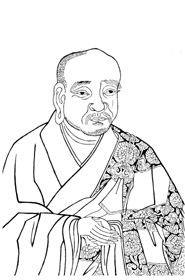
One of the first and best known is Aśvaghoṣa, of whom two complete "Great Poems" ( mahākāvya ) survive, i.e. the "Acts of the Buddha" ( Buddhacarita . [6] ) and "Handsome Nanda" (Saundarananda [7] ). The first tells the life-story of Śākyamuni Buddha, while the second tells the story of Nanda, the Buddha's handsome cousin, who was guided towards liberation by turning his greatest weakness – desire – into a motivating factor for practice. Fragments of a drama called Śāriputraprakaraṇa ( [8] ) are also extant, and these may be some of the oldest, perhaps even the oldest example of Sanskrit drama. Aśvaghoṣa's verses are often simple yet very suggestive, casting key Buddhist teachings, such as impermanence, in evocatively paced similes:
vihagānāṁ yathā sāyaṁ | Like birds in the evening |
Other verses of Aśvaghoṣa capture in vivid images human indecision, uncertainty and sorrow. The following verse describes Nanda at the door of his house, torn between the wish to remain with his beloved wife and the sense of respect that prompts him to leave and meet the Buddha to make amends for neglecting the Buddha's alms-round in front of his house:
taṅ gauravaṃ buddhagataṃ cakarṣa | Respect for the Buddha pulled him away |
Sanskrit poetry is subdivided into three types: verse works (padya) prose works (gadya) and mixed works (campū); nowhere in the Indic tradition is versification taken as the distinguishing feature of literary diction, as all sorts of works, whether philosophical, medical, etc., were composed in verse, for ease of memorization. Several Buddhist authors specialized in mixed verse-prose compositions, often re-telling traditional stories about the Buddha's previous births ( jātaka ). Among the authors writing on the basis of the Jātakas, most prominent is perhaps Āryaśūra; [12] [13] [14] [15] [16] other beautiful collections of literary Jātakas are those of Haribhaṭṭa [17] and Gopadatta. Haribhaṭṭa's collection includes a concise version of the life story of Śākyamuni Buddha; he describes Māra's dejection after understanding the Buddha's victory and superiority in the following verse:
evam ukte 'tha śākyendre | After the Lord of the Śākyas had said this, |
This is reminiscent of a famous verse from Kālidāsa's Kumārasaṁbhava , [18] and the (probably intended) contrast between the two verses is itself suggestive.
evaṃ vādini devarṣau pārśve pitur adhomukhī | While the divine Sage was thus speaking, |
Kālidāsa celebrates the budding presence of the God of Love in Pārvatī’s mind, as she is thrilled to hear a discussion about her future husband; Haribhaṭṭa describes the Love God’s defeat at the time of the Buddha’s Awakening. Pārvatī is holding lotus-petals; Māra is holding a wooden stick.
Another important type of mixed verse/prose works is Sanskrit drama (nāṭaka), and here king Harṣadeva deserves special mention. The patron of the great Chinese monk Xuanzang composed the Nāgānanda, [21] an outstanding drama based on the traditional story of Jīmūtavāhana, prince of the Vidyādharas. While perfectly at ease within the conventions of court poetry, including the depiction of love and attraction, Harṣadeva's Nāgānanda is suffused with Buddhist reflections on compassion and on the futility of hatred, and on impermanence and the inevitability of death. The following words are spoken by a brave Nāga boy to his mother, who is suffering from extreme sorrow as her child will soon be sacrificed to the voracious bird Garuḍa:
kroḍīkaroti prathamaṃ | Impermanence embraces the new-born, |
Another genre where Buddhist poets excelled is the "good-sayings" (subhāṣita), collections of proverb-like verses often dealing with universally applicable principles not so specific to the Buddhist tradition. One such collection of verses is attributed to the Buddha himself, and preserved in different versions as the Udānavarga (Sanskrit), [22] Dhammapada (Pāli), Dharmapada (Prākr̥t and Gāndhārī). This collection often uses similes (upamā) to exemplify key Buddhist teachings:
nāsti kāmasamo hy ogho | There is no flood like desire, |
Other significant collections are Ravigupta's Āryakośa, Vararuci's Gāthāśataka, Ratnamati's Prakaraṇa, [23] and several others. One of the largest anthologies of good sayings extant in Sanskrit is by a Buddhist abbot, i.e. Vidyākara's Subhāṣitaratnakośa. [24] The Subhāṣita genre became also well-established in Tibet, one of the greatest examples being Sakya Paṇḍita, an early and influential master of the Sakyapa school, known to have been fluent in Sanskrit from an early age.
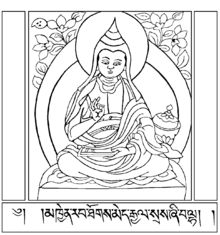
Ārya Śāntideva's "Entrance into the practice of the Bodhisattvas" ( Bodhicaryāvatāra ) [25] partly resembles a collection of good sayings, yet in many ways defies classification. It is written in a number of rather different literary registers, resembling court poetry in places, while being very dramatic in others; some verses are indeed "good-sayings", in both content and style, while an entire chapter is written in the confident and terse tone of a Madhyamaka philosophical text, with the usual alternation of objections and rebuttals. The work is a compendium of Mahāyāna practice, covering the six perfections (pāramitā) which may be said to function as its main structural guideline. The "Compendium of Perfections" by Āryaśūra is another such guide, containing numerous excellent verses and organized even more systematically in terms of the six perfections.
Other guides to Buddhist practices were written in the form of versified letters; among these, the "Letter to a Friend" (Suhr̥llekhā) and the "Garland of Gems" (Ratnāvalī [26] ) of Nāgārjuna deserve special mention, not just for their content and style, but also for being very influential in India and Tibet; another remarkable epistle extant in Sanskrit is Candragomin's "Letter to a disciple" (śiṣyalekhā [27] ), also outlining the Buddhist path for a disciple. These letters exemplify the friendly and respectful relationship between Buddhist masters and their patrons, who received advice on a number of different topics, both worldly and supramundane.
Buddhist poets wrote very many praises of the Buddha, Dharma and Saṅgha, and of Bodhisattvas and meditational deities. [28] The One Hundred and Fifty Verses of Mātr̥ceṭa seem to have been particularly popular; Nandipriya's extensive commentary on this work still survives in the Tibetan Tangyur (Śatapañcaśatkanāmastotraṭīkā, Brgya lṅa bcu pa źes bya ba’i bstod pa’i ’grel pa, Tg bstod tshogs ka 116a5-178a1.). Mātr̥ceṭa's verses use accessible language, with strong echoes from different types of Buddhist literature, and transmit a sense of great devotion all the more highlighted by the poet's restrained and measured diction:
samyaksaṃbodhibījasya | Seed of perfect awakening, |
Buddhist praises often have didactic purposes; some of them (like Nāgārjuna's Catuḥstava) expound philosophical ideas of specific schools, while praises of Bodhisattvas and meditational deities often facilitate readers/listeners in acquiring familiarity with important features that become the focus of recollection and or formal meditative contemplation.
Buddhist authors also wrote on prosody (chandas), offering their own poetic examples for different types of Sanskrit meter. Two notable works on Sanskrit poetry are the Chandoratnākara of Ratnākaraśānti [30] and the Vr̥ttamālāstuti of Jñānaśrīmitra, [31] by two great contemporary Vikramaśīla masters who were active on several intellectual fronts and well-known exponents of Yogācāra thought. The Vr̥ttamālāstuti is particularly striking: it consists in verses of praise of the Bodhisattva of Wisdom, Mañjuśrī, which at the same time offer information about the verse that is being exemplified, such as its name and the position of the caesura (yati). A simple example, for the śaraṇa meter:
prasīda bhagavan | Be well-disposed, Bhagavat! |
Pāli poetry follows very similar patters as Sanskrit poetry, in terms of prosody, vocabulary, genres, and poetic conventions; indeed several Pāli authors were well conversant with Sanskrit and even composed works in that language (such as, for example, the Anuruddhaśataka). Sanskrit meters and poetic conventions were more broadly very influential throughout South-East Asia even in respect to vernacular languages (Thai, Burmese, etc.), also thanks to the popularity of literary aesthetic ideas from the tradition of Alaṁkāraśāstra ("The science of ornaments") regarding the purposes and nature of literature.
While discussing praises, literary praises of meditational deities have been briefly mentioned; this brings us into the fold of Buddhist Tantric poetry, which is esoteric in character and thus often laden with evocative symbols meant to be understood only thanks to one's relationship with a living master. Notable are the "Songs of Practice" (Caryāgīti [33] ), written in Apabhraṁśa rather than Sanskrit, and including among their authors the "Great Accomplished Ones" (mahāsiddha), such as Saraha, Śāntipā, and many others.

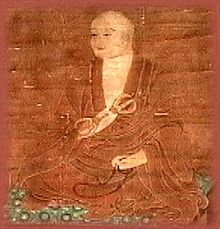






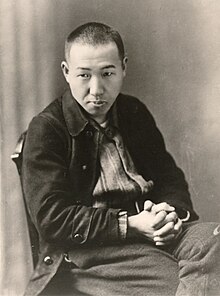
Buddhist poetry – like the bulk of the scriptures produced by Buddhists – is not limited to compositions in Pali and Sanskrit; it has flourished in practically every language that Buddhists speak.
To exemplify the use of specialized Buddhist metaphor, this well-known poem by Hanshan (Tang Dynasty) will suffice:
我心如秋月 | My mind is like the autumn moon, |
In medieval Japan, Buddhist poetry was accorded a special status of a separate genre within the corpus of the waka collections.
1. The earliest extant collection of the Japanese poetry, the Man'yōshū , contains a preface (Jp. jo 序 or daishi 題詞) to two poems on the love of parents towards their children: "Sakyamuni expounds truthfully from his golden mouth, 'I love all things equally, the way I love my child, Rahula.' He also teaches that 'no love is greater than the love for ones child.' Even the greatest of saints cherishes his child. Who, then, among the living creatures of this world could fail to love children claimed as one's own?" [41] There are several prefaces and poems in the Man'yōshū that mention the name of Buddha Śākyamuni (Jp. Shaka Nyorai 釋迦如来 /an honorific title of Siddhārtha Gautama), Buddhist temples (Jp. tera 寺), monks and nuns. [42]
2. Among the treasures of Yakushi-ji Temple in Nara there are stone blocks dating from the Nara period modeled as "the footsteps" of the Buddha (Jp. Bussokuseki 佛足石). These blocks contain poems in man'yōgana that may be considered the oldest Buddhist waka (Japanese language poems) known to date. These poems are usually referred to as bussokusekika (lit. "poems on stone imprints of Buddha's feet": 仏足石歌). Consider the following example:
misoji amari | Rare indeed |
Both examples above have one trait in common. Namely, the focus on the physical characteristics of the Buddha is prominent: "the golden mouth" of the Buddha in the Man'yoshu and the "feet of the Buddha" in the stone inscriptions relate to the marks of perfection of the Buddha's body / speech (Skt. mahāpuruṣa, lit. [signs of] "a great person"). [44]
In the Heian period, Buddhist poetry began to be anthologized in the Imperial Anthologies (Jp. chokusenshū 勅選集. Among the 21 Imperial Anthologies, 19 contain Buddhist tanka (lit. short waka) starting with the Shūi Wakashū , compiled between 1005 and 1007 C.E.
The first Imperial Anthology to treat Buddhist tanka as a separate genre, i.e. shakkyōka (lit. "Poems of Śākyamuni's Teaching": 釈教歌), is the Senzai Wakashū , which has an exclusive section dedicated to the Buddhist Poems in Volume 19 (第十九巻). Among the most famous poets who wrote shakkyōka are: Saigyō; Jakuren; Kamo no Chōmei; Fujiwara no Shunzei; Jien; Nōin; Dōgen, Ton'a, etc. Many of the so-called "Thirty-six Poetry Immortals" wrote Buddhist poetry.
Shakkyōka can be subdivided according to the ten following motifs:
These motifs are not mutually exclusive and are very often combined within a given poem.
One of the most famous collections of Japanese tanka of the Kamakura period, the Hyakunin Isshu contains several shakkyōka, for instance Poem 95, by Jien (also anthologized in the Senzai Wakashū: 巻十七, 雑中, No. 1137):
おほけなく | Unworthy though I am, |
In later periods, as tanka was slowly being overshadowed by renga and haiku – the two poetic forms that derived from tanka – such famous poets as "the seven worthies of renga", (Jp. renga shichiken 連歌七賢) of the Muromachi period, [47] Sōgi, and still later, Matsuo Bashō, Kobayashi Issa, among many others, carried on the tradition of Buddhist poetry with their compositions.
菊の香や | Kiku no ka ya | In the city of Nara |
The nostalgic feeling of the ancient capital, Nara – interspersed with the scent of chrysanthemums (symbol of Japanese monarchy) and the old Buddha statues – captures well the aesthetic ideals of sabi and yūgen in this famous haiku. Although these three lines appear to be a mere utterance of almost prosaic quality, the imagery invoked is far from simplistic. Buddhas, emperors, passage of time, the ethereal beauty of flowers that presents itself obliquely, i.e., appealing to scent rather than sight – all suggest that the poet sought to use language as a medium of condensed imagery to map an immediate experience, whose richness can only be read in the blanks.
露の世は露の世ながらさりながら
tsuyu no yo wa tsuyu no yo nagara sari nagara
This world of dew
is just a world of dew,
and yet...
Issa
Here the poet uses the image of evanescence of our world, the dewdrop – one of the classical allegories of the Buddhist teaching – to express grief caused by the death of his daughter. In theory, Buddhism teaches its followers to regard all the vicissitudes of life as transitory and ephemeral, akin to magic apparitions without substance or dewdrops soon to evaporate under the sun. Yet, a father's loss of his child is more than reason can counter. [49]
As Japan reached the era of industrialized modernity, many of the poets of the Meiji period started to experiment with the European styles of poetic composition. Some poets, notably Miyazawa Kenji—a devout Buddhist who expressed his convictions in his poetry and fiction—often composed poems with Buddhist overtones. His Ame ni mo Makezu (雨ニモマケズ), known to practically every Japanese today, [50] takes its theme (Chapter 14: Peaceful and Joyous Deeds / Jp. Anrakugyō 安楽行) from the Lotus Sutra 妙法蓮華經, which Kenji revered. [51]
Another Buddhist poem that remains well known today, but for non-religious reasons, is the Iroha poem from the Heian period. Originally written in man'yōgana and attributed to Kūkai, this Buddhist poem contains every kana precisely once, and is learned in Japanese primary schools mainly for this reason. Many old-style Japanese dictionaries adhere to the Iroha order.
A modern Indian Sanskrit poet, Vanikavi Dr. Manomohan Acharya, wrote Sri Gautama Buddha Panchakam in simple and lucid Sanskrit through lyrical style. [52]
New Delhi: Aditya Prakashan, 2011.

A mantra or mantram is a sacred utterance, a numinous sound, a syllable, word or phonemes, or group of words believed by practitioners to have religious, magical or spiritual powers. Some mantras have a syntactic structure and literal meaning, while others do not.

The Jātaka are a voluminous body of literature native to the Indian subcontinent which mainly concern the previous births of Gautama Buddha in both human and animal form. Jataka stories, were depicted on the railings and torans of the stupas. According to Peter Skilling, this genre is "one of the oldest classes of Buddhist literature." Some of these works are also considered great works of literature in their own right.

The Dhammapada is a collection of sayings of the Buddha in verse form and one of the most widely read and best known Buddhist scriptures. The original version of the Dhammapada is in the Khuddaka Nikaya, a division of the Pali Canon of Theravada Buddhism.
Yāna refers to a mode or method of spiritual practice in Buddhism. It is claimed they were all taught by the Gautama Buddha in response to the various capacities of individuals. On an outwardly conventional level, the teachings and practices may appear contradictory, but ultimately they all have the same goal.

Buddhist texts are religious texts that belong to, or are associated with, Buddhism and its traditions. There is no single textual collection for all of Buddhism. Instead, there are three main Buddhist Canons: the Pāli Canon of the Theravāda tradition, the Chinese Buddhist Canon used in East Asian Buddhist tradition, and the Tibetan Buddhist Canon used in Indo-Tibetan Buddhism.
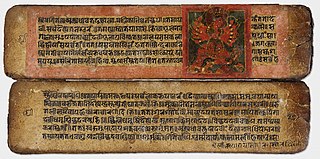
Sanskrit literature broadly comprises all literature in the Sanskrit language. This includes texts composed in the earliest attested descendant of the Proto-Indo-Aryan language known as Vedic Sanskrit, texts in Classical Sanskrit as well as some mixed and non-standard forms of Sanskrit. Literature in the older language begins with the composition of the Ṛg·veda between about 1500 and 1000 BCE, followed by other Vedic works right up to the time of the grammarian Pāṇini around 6th or 4th century BCE.

The Sutta Piṭaka is the second of the three divisions of the Tripiṭaka, the definitive canonical collection of scripture of Theravada Buddhism. The other two parts of the Tripiṭaka are the Vinaya Piṭaka and the Abhidhamma Piṭaka. The Sutta Pitaka contains more than 10,000 suttas (teachings) attributed to the Buddha or his close companions.

Aśvaghoṣa, also transliterated Ashvaghosha,, was a Buddhist philosopher, dramatist, poet, musician, and orator from India. He was born in Saketa, today known as Ayodhya.
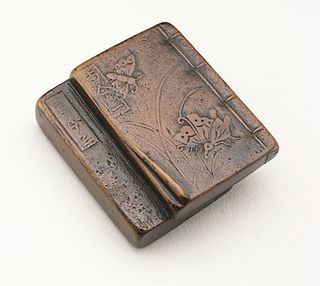
Japanese poetry is poetry typical of Japan, or written, spoken, or chanted in the Japanese language, which includes Old Japanese, Early Middle Japanese, Late Middle Japanese, and Modern Japanese, as well as poetry in Japan which was written in the Chinese language or ryūka from the Okinawa Islands: it is possible to make a more accurate distinction between Japanese poetry written in Japan or by Japanese people in other languages versus that written in the Japanese language by speaking of Japanese-language poetry. Much of the literary record of Japanese poetry begins when Japanese poets encountered Chinese poetry during the Tang dynasty. Under the influence of the Chinese poets of this era Japanese began to compose poetry in Chinese kanshi); and, as part of this tradition, poetry in Japan tended to be intimately associated with pictorial painting, partly because of the influence of Chinese arts, and the tradition of the use of ink and brush for both writing and drawing. It took several hundred years to digest the foreign impact and make it an integral part of Japanese culture and to merge this kanshi poetry into a Japanese language literary tradition, and then later to develop the diversity of unique poetic forms of native poetry, such as waka, haikai, and other more Japanese poetic specialties. For example, in the Tale of Genji both kanshi and waka are frequently mentioned. The history of Japanese poetry goes from an early semi-historical/mythological phase, through the early Old Japanese literature inclusions, just before the Nara period, the Nara period itself, the Heian period, the Kamakura period, and so on, up through the poetically important Edo period and modern times; however, the history of poetry often is different from socio-political history.

Subhūti was one of the ten principal disciples of the Buddha. In Theravada Buddhism he is considered the disciple who was foremost in being "worthy of gifts" and "living remote and in peace". In Mahayana Buddhism, he is considered foremost in understanding emptiness.
Gāthā is a Sanskrit term for 'song' or 'verse', especially referring to any poetic metre which is used in legends, and is not part of the Vedas but peculiar to either Epic Sanskrit or to Prakrit. The word is originally derived from the Sanskrit/Prakrit root gai, which means 'to speak, sing, recite or extol', cognate to the Avestan term gatha.

The Theragatha is a Buddhist text, a collection of short poems in Pali attributed to members of the early Buddhist sangha. It is classified as part of the Khuddaka Nikaya, the collection of minor books in the Sutta Pitaka. A similar text, the Therigatha, contains verses attributed to early Buddhist nuns.

The Therīgāthā, often translated as Verses of the Elder Nuns, is a Buddhist text, a collection of short poems of early enlightened women who were elder nuns. The poems date from a three hundred year period, with some dated as early as the late 6th century BCE. According to Thanissaro Bhikkhu, the Therigatha is the "earliest extant text depicting women’s spiritual experiences."

Kātyāyana or Mahākātyāyana was a disciple of Gautama Buddha. He is listed as one of the ten principal disciples and was foremost in expanding on and explaining brief statements of the Buddha.

Mahākāvya, also known as sargabandha, is a genre of Indian epic poetry in Classical Sanskrit. The genre is characterised by ornate and elaborate descriptions of scenery, love, battles and so on — in short, everything that tests a poet's skill at description. Typical examples of mahākāvya are the Kumarasambhava and the Kiratarjuniya.

The Pāli Canon is the standard collection of scriptures in the Theravada Buddhist tradition, as preserved in the Pāli language. It is the most complete extant early Buddhist canon. It derives mainly from the Tamrashatiya school.

Waka is a type of poetry in classical Japanese literature. Although waka in modern Japanese is written as 和歌, in the past it was also written as 倭歌, and a variant name is yamato-uta (大和歌).
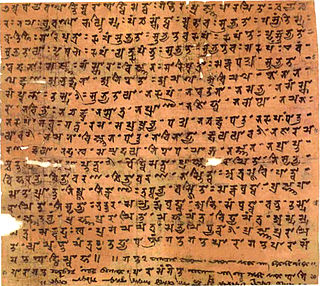
Sanskrit Buddhist literature refers to Buddhist texts composed either in classical Sanskrit, in a register that has been called "Buddhist Hybrid Sanskrit", or a mixture of these two. Several non-Mahāyāna Nikāyas appear to have kept their canons in Sanskrit, the most prominent being the Sarvāstivāda school. Many Mahāyāna Sūtras and śāstras also survive in Buddhistic Sanskrit or in standard Sanskrit.
Early Buddhist texts (EBTs), early Buddhist literature or early Buddhist discourses are parallel texts shared by the early Buddhist schools. The most widely studied EBT material are the first four Pali Nikayas, as well as the corresponding Chinese Āgamas. However, some scholars have also pointed out that some Vinaya material, like the Patimokkhas of the different Buddhist schools, as well as some material from the earliest Abhidharma texts could also be quite early.